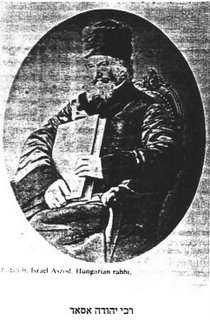Mary Roach in her excellent book “Stiff: The Curious Lives of Human Cadavers” discusses some of the facinating facts relating to dead bodies. However, she does not discuss some of the more interesting Jewish incidents of dead bodies.
The first is the fairly well known story of R. Yehuda Aszod (1794-1866). R. Aszod’s grandson wrote a biography of his grandfather. Portions of this biography are included in R. Aszod’s commentary on the Torah, Divre Mahri.
“My grandfather never allowed for a picture or portrait of himself [based upon halachik reasons, for more on these reasons see G. Oberlander’s article in the latest Hechal haBeshet]. However, many of his students wanted his picture to remember their teacher. Therefore some of his students decided amongst themselves that after R. Aszod will die they will dress him in his Shabbat clothes, place him on his chair and this is how they obtained his photograph which is found in many people’s homes. However, those that participated in this bad befell them. It was not longer before the participants all died.”  This event even engendered a discussion whether such a practice is permitted. R. Zev Tzvi Klien in his teshuvot Kehana Mesaya Kehana (no. 12) discusses this practice and concludes although not recommended it is not prohibited.
This event even engendered a discussion whether such a practice is permitted. R. Zev Tzvi Klien in his teshuvot Kehana Mesaya Kehana (no. 12) discusses this practice and concludes although not recommended it is not prohibited.
While this story does appear in R. Aszod’s commentary on the torah (p. 32) it is only is the older editions, the most recent the entire story including the relevant footnote was removed.
Additionally, there is a picture of R. Aryeh Leib ben Asher Gunzberg (Sha’agat Areyeh) which it appears he is dead. However, the legend underneath the picture reads “This is the picture of the Sha’agat Areyeh at the time he is dying.” I assume this “disclaimer” was placed there to mitigate any criticism of the kind the picture of R. Aszod is subject to. One can see this picture in the book R. Y.M. Stern, Gedoli HaDorot Jerusalem 1996, vol. 1.
There is another case, although not with a dead Rabbi, but with a Jewish question regarding the dead. In University College in London the noted philosopher Jermey Bentham had an interesting request in his will. As it appears on Wikipedia,
A further reason for Jeremy Bentham’s fame within UCL is due to the fact that his body is on display to the public. Jeremy Bentham specified in his will that he wanted his body to be preserved as a lasting memorial, and this instruction was duly carried out. This ‘Auto-Icon’ has become famous. Unfortunately, when it came to preserving his head, the process went disastrously wrong and left the head badly disfigured. A wax head was made to replace it, but for many years the real head sat between his legs. However, this head was frequently stolen and subjected to many student pranks, with students from rival King’s College London often the culprits. The head is said to have at one time been found in a luggage locker at Aberdeen station, and to have been used as a football by students in the Quad. These events led to the head being removed from display and placed instead in the College vaults, where it remains to this day.
Other rumours surrounding the Auto-Icon are that the box containing his remains is wheeled into senior college meetings, and that he is then listed in minutes as ‘present but not voting’. He is also said to have a vote on the council, but only when the vote is split, and that he always votes in favour of the motion.
When the Upper Refectory was refurbished in2003, the room became renamed the Jeremy Bentham Room (sometimes abbreviated JBR) in tribute to the man.
The London Bet Din for a few years put out phamphelts where they would discuss a in depth topics of interest. One of those titled “B’Inyan Ohel ha-Met” Dayan Grosnas no. 14, 1965, discusses whether a Kohen can go through the lobby, or today the JBR where Bentham’s body is. They actually state in the begining, which is not mentioned in the Wikipedia article that the head is kept in a special box, which although not on public display, if one asks it will be shown to you. Obviously, the same question of whether one could photograph it as was raised in the case of R. Aszod would apply as well.
You can see Bentham’s body here.
